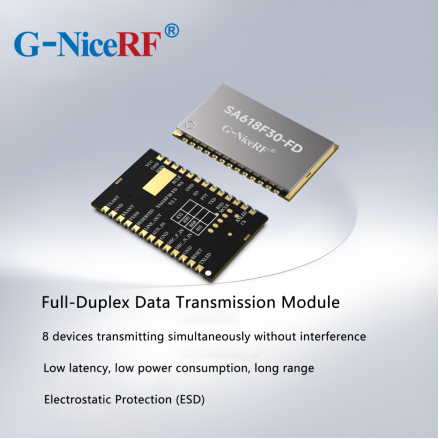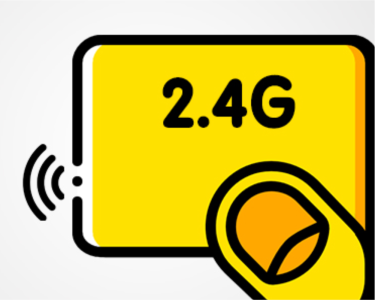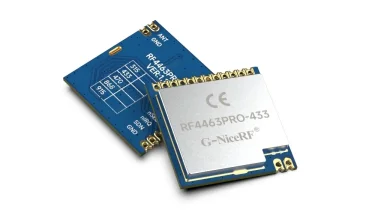Full-duplex, multi-channel concurrent, low-latency data transmission solves industry signal congestion issues
In many industries, real-time and efficient data transmission is crucial. Whether it's sensor networks in industrial automation, Automated Guided Vehicles (AGV) in warehousing and logistics, or applications like autonomous driving and smart agriculture, stable wireless communication is essential for transmitting instructions and receiving feedback. However, many industries currently face the following challenges:
Communication Delay:Many traditional communication modules use half-duplex communication modes, where data transmission and reception alternate over time. This leads to higher latency, which severely affects system efficiency, especially in scenarios requiring real-time feedback.
Channel Congestion and Interference:In dense industrial environments or city centers, multiple devices often share the same frequency band for communication, causing channel congestion. This leads to data loss and increased latency. Interference between communication devices is another major issue, especially when radio frequency resources are limited.
Insufficient Concurrent Communication Capacity:With the rapid growth of IoT devices, many devices need to communicate simultaneously. However, traditional communication modules have limited concurrent capacity, making it difficult to handle a large number of simultaneous requests. This reduces data transmission efficiency in scenarios such as smart factories and smart cities, affecting the overall system performance.
Data Reliability and Transmission Stability:In high-interference environments, communication signals are easily disrupted, resulting in data packet loss and affecting business operations. In scenarios such as industrial automation and remote monitoring, where real-time performance and data accuracy are critical, traditional communication modes often struggle to meet the required standards.
Full-duplex communication, as an advanced communication method, allows devices to send and receive data simultaneously, overcoming the limitations of simplex (one-way transmission) and half-duplex (alternating between sending and receiving). In comparison, full-duplex significantly enhances communication efficiency, reducing data latency and eliminating bottlenecks caused by channel switching. This makes it particularly suitable for scenarios with high demands for real-time performance and high concurrency, such as industrial automation, IoT, and smart cities. With full-duplex technology, devices can maintain stable and efficient two-way communication even in complex environments, providing robust support for modern wireless communication technology.
Full-Duplex Multi-Channel Concurrent, Low-Latency Data Transmission Solution
Full-duplex high-concurrency technology offers an effective solution to data congestion issues in various industries. Full-duplex communication enables devices to send and receive data simultaneously, eliminating the need for polling or channel switching, thus significantly enhancing communication efficiency. When combined with high-concurrency technology, full-duplex modules support parallel communication among multiple devices, ensuring smooth, low-latency, and low-interference communication even in densely populated environments.
The SA618F30-FD is an 8-channel full-duplex wireless data communication module capable of simultaneous transmission from up to 8 transmitters without mutual interference. This enables operation in complex environments where multiple transmitters are active simultaneously, minimizing the likelihood of retransmission and significantly reducing the chances of interference and being interfered with. Additionally, the module features built-in ESD protection, safeguarding against high voltage, system crashes, and reverse polarity issues.
Advantages of the SA618F30-FD in Addressing Signal Congestion Issues
Enhanced Communication Efficiency and Reduced Latency:
The SA618F30-FD full-duplex module enables simultaneous data transmission and reception, significantly reducing communication latency to no more than 50ms. This is particularly beneficial in scenarios with high real-time demands. For instance, in smart manufacturing environments, where automation equipment needs to rapidly exchange instructions and feedback, traditional half-duplex communication can cause delays that disrupt production flow. Full-duplex communication ensures that instructions are transmitted instantly, thereby improving production efficiency.
Support for Multi-Channel Concurrent Communication:
The SA618F30-FD supports simultaneous data interaction from up to 8 devices with the main control system without causing channel conflicts or delays. This is crucial for applications requiring real-time data transmission, such as smart grids, smart parking systems, and intelligent transportation. For example, in a smart grid, multiple monitoring devices need to upload data to the central system in real time. The full-duplex high-concurrency technology ensures smooth and timely data transmission.
Full-duplex multi-channel concurrent technology is revolutionizing wireless communication by addressing the latency, channel congestion, and concurrent communication limitations of traditional half-duplex systems. As industries increasingly demand real-time performance, reliability, and communication efficiency, full-duplex high-concurrency technology is set to become a core driver in the future of wireless communication, pushing various sectors toward greater intelligence and efficiency.
 +86-755-23080616
+86-755-23080616
 sales@nicerf.com
sales@nicerf.com
Website: https://www.nicerf.com/
Address: 309-314, 3/F, Bldg A, Hongdu business building, Zone 43, Baoan Dist, Shenzhen, China






